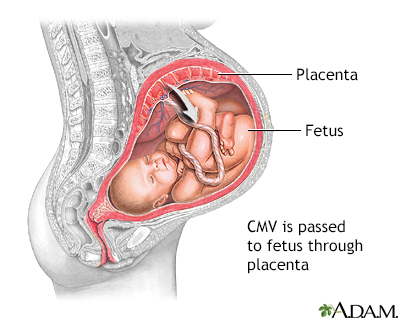Congenital cytomegalovirus
Definition
Congenital cytomegalovirus is a condition that can occur when an infant is infected with a virus called cytomegalovirus (CMV) before birth. Congenital means the condition is present at birth.
Alternative Names
CMV - congenital; Congenital CMV; Cytomegalovirus - congenital
Causes
Congenital CMV occurs when an infected mother passes CMV to the fetus through the placenta. The mother may not have symptoms, so she may be unaware that she has CMV.
Symptoms
Most children infected with CMV at birth do not have symptoms. Those who do have symptoms may have:
- Inflammation of the retina
- Yellow skin and whites of the eyes (jaundice)
- Large spleen and liver
- Low birth weight
- Mineral deposits in the brain
- Rash at birth
- Seizures
- Small head size
Exams and Tests
During the exam, the health care provider may find:
- Abnormal breath sounds indicating pneumonia
- Enlarged liver
- Enlarged spleen
- Delayed physical movements (psychomotor retardation)
Tests include:
- Antibody titer against CMV for both the mother and infant
- Bilirubin level and blood tests for liver function
- CBC
- CT scan or ultrasound of the head
- Fundoscopy
- TORCH screen
- Urine culture for CMV virus in the first 2 to 3 weeks of life
- X-ray of the chest
Treatment
There is no specific treatment for congenital CMV. Treatments focus on specific problems, such as physical therapy and appropriate education for children with delayed physical movements.
Treatment with antiviral medicines is often used for infants with neurologic (nervous system) symptoms. This treatment may reduce hearing loss later in the child's life.
Outlook (Prognosis)
Most infants who have symptoms of their infection at birth will have neurologic abnormalities later in life. Most infants without symptoms at birth will NOT have these problems.
Some children may die while they are still an infant.
Possible Complications
Complications may include:
- Difficulty with physical activities and movement
- Vision problems or blindness
- Deafness
When to Contact a Medical Professional
Have your baby checked right away if a provider did not examine your baby shortly after birth, and you suspect your baby has:
- A small head
- Other symptoms of congenital CMV
If your baby has congenital CMV, it is important to follow your provider's recommendations for well-baby examinations. That way, any growth and development problems can be identified early and treated promptly.
Prevention
Cytomegalovirus is almost everywhere in the environment. The US Centers for Disease Control and Prevention (CDC) recommend the following steps to reduce the spread of CMV:
- Wash hands with soap and water after touching diapers or saliva.
- Avoid kissing children under the age of 6 on the mouth or cheek.
- Do not share food, drinks, or eating utensils with young children.
- Pregnant women working in a day care center should work with children older than age 2½.
Gallery


References
Beckham JD, Solbrig MV, Tyler KL. Viral encephalitis and meningitis. In: Jankovic J, Mazziotta JC, Pomeroy SL, Newman NJ, eds. Bradley and Daroff's Neurology in Clinical Practice. 8th ed. Philadelphia, PA: Elsevier; 2022:chap 78.
Britt WJ. Cytomegalovirus (CMV). In: Bennett JE, Dolin R, Blaser MJ, eds. Mandell, Douglas, and Bennett's Principles and Practice of Infectious Diseases. 9th ed. Philadelphia, PA: Elsevier; 2020:chap 137.
Huang FAS, Brady RC. Congenital and perinatal infections. In: Kliegman RM, St. Geme JW, Blum NJ, Shah SS, Tasker RC, Wilson KM, eds. Nelson Textbook of Pediatrics. 21st ed. Philadelphia, PA: Elsevier; 2020:chap 131.
